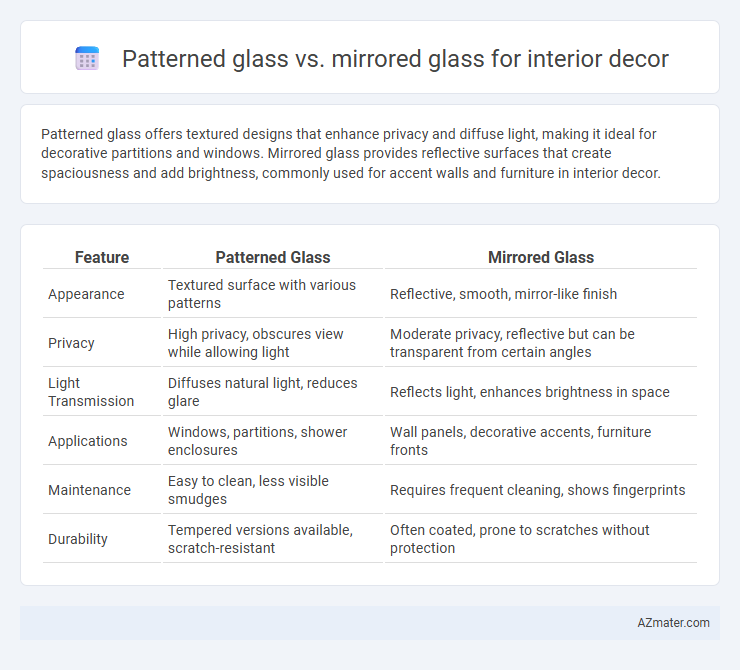Patterned glass offers textured designs that enhance privacy and diffuse light, making it ideal for decorative partitions and windows. Mirrored glass provides reflective surfaces that create spaciousness and add brightness, commonly used for accent walls and furniture in interior decor.
Table of Comparison
| Feature | Patterned Glass | Mirrored Glass |
|---|---|---|
| Appearance | Textured surface with various patterns | Reflective, smooth, mirror-like finish |
| Privacy | High privacy, obscures view while allowing light | Moderate privacy, reflective but can be transparent from certain angles |
| Light Transmission | Diffuses natural light, reduces glare | Reflects light, enhances brightness in space |
| Applications | Windows, partitions, shower enclosures | Wall panels, decorative accents, furniture fronts |
| Maintenance | Easy to clean, less visible smudges | Requires frequent cleaning, shows fingerprints |
| Durability | Tempered versions available, scratch-resistant | Often coated, prone to scratches without protection |
Introduction: Comparing Patterned Glass and Mirrored Glass
Patterned glass enhances interior decor by offering textured surfaces that diffuse light, providing privacy while adding artistic detail to spaces. Mirrored glass creates reflective surfaces that amplify natural light and visually expand rooms, contributing to a modern and sleek aesthetic. Choosing between patterned and mirrored glass depends on desired light diffusion, privacy needs, and stylistic preferences within interior design.
Aesthetic Appeal: Visual Impact in Modern Interiors
Patterned glass enhances modern interiors by introducing intricate textures and diffused light effects that add depth and visual interest without overwhelming the space. Mirrored glass creates a sleek, reflective surface that amplifies natural light and visually expands rooms, contributing to a clean and sophisticated aesthetic. Choosing between patterned and mirrored glass depends on the desired ambiance, with patterned glass offering subtle complexity and mirrored glass emphasizing brightness and openness.
Privacy Solutions: Patterned vs Mirrored Glass
Patterned glass offers privacy by distorting visibility while allowing natural light to pass through, making it ideal for interior spaces requiring subtle separation. Mirrored glass provides a one-way privacy effect during daylight by reflecting exterior views and obscuring interiors, but loses this advantage in low light conditions. Choosing between patterned and mirrored glass depends on the balance needed between privacy, light diffusion, and aesthetic preferences in interior decor.
Light Diffusion and Reflection Properties
Patterned glass enhances interior decor by diffusing natural light, creating a soft, muted ambiance that reduces glare and maintains privacy without compromising brightness. Mirrored glass reflects light intensively, amplifying room illumination and creating the illusion of expanded space, but may cause glare and reduce privacy. Choosing between patterned and mirrored glass depends on the desired balance of light diffusion, reflection, privacy, and aesthetic effect in interior spaces.
Functional Versatility in Interior Applications
Patterned glass offers functional versatility by providing privacy while allowing natural light to diffuse through, making it ideal for partitions, shower enclosures, and decorative panels. Mirrored glass enhances interior space by reflecting light and creating an illusion of openness, often utilized in wardrobes, wall accents, and ceiling applications to amplify room size visually. Selecting between patterned and mirrored glass depends on balancing privacy needs with spatial enhancement in various interior design contexts.
Maintenance and Durability Considerations
Patterned glass offers enhanced scratch resistance and is less prone to showing fingerprints, making it easier to maintain in high-traffic interior decor areas. Mirrored glass, while visually striking, requires frequent cleaning to prevent streaks and tarnishing, especially in humid environments. Durability-wise, patterned glass tends to be more resilient to everyday wear, whereas mirrored glass can be more susceptible to damage from impact and moisture exposure.
Cost Analysis: Budgeting for Glass Choices
Patterned glass typically costs less than mirrored glass due to simpler manufacturing processes and lower material expenses, making it a budget-friendly choice for interior decor. Mirrored glass demands higher investment because of specialized coatings and enhanced reflective properties, which can increase installation and maintenance costs. When budgeting for glass choices, considering long-term durability and aesthetic impact alongside initial price helps optimize value in interior design projects.
Space Enhancement: Creating Illusions with Glass
Patterned glass enhances interior spaces by diffusing light softly, creating textured reflections that add depth and visual interest without overwhelming the room. Mirrored glass amplifies natural light and visually doubles the area, making spaces appear larger and more open. Combining these glass types strategically can optimize spatial perception and elevate the ambiance of any interior setting.
Design Flexibility: Customization Options
Patterned glass offers extensive design flexibility through customizable textures, colors, and patterns, allowing for unique and personalized interior decor solutions that enhance privacy and light diffusion. Mirrored glass provides options for full or partial reflection with variations in tint and frame styles, enabling sleek, modern aesthetics that visually expand spaces and add depth. Both materials support bespoke dimensions and finishes, but patterned glass excels in creative expression while mirrored glass emphasizes spatial manipulation and brightness enhancement.
Choosing the Right Glass for Your Interior Style
Patterned glass introduces texture and subtle privacy to interiors, ideal for creating visual interest in traditional or rustic designs, while mirrored glass enhances light reflection and spatial perception, perfect for modern and minimalist styles. Selecting patterned glass complements spaces requiring diffused daylight and a tactile aesthetic, whereas mirrored glass suits rooms that benefit from brightness and the illusion of expanded space. Consider the functional needs and stylistic goals of your interior to determine whether the decorative detail of patterned glass or the sleek sophistication of mirrored glass aligns best with your design vision.

Infographic: Patterned glass vs Mirrored glass for Interior decor
 azmater.com
azmater.com